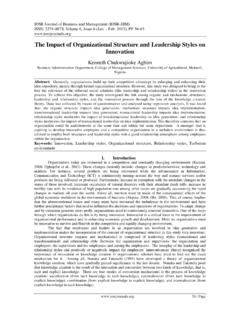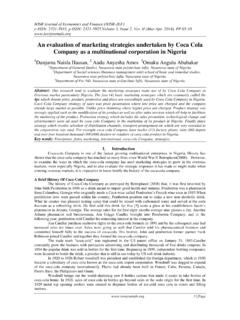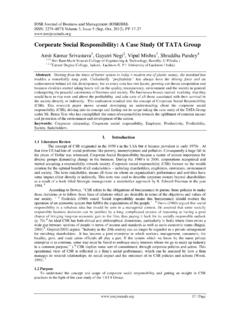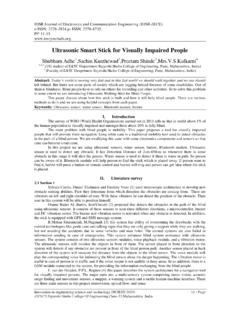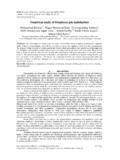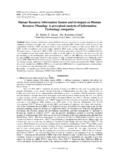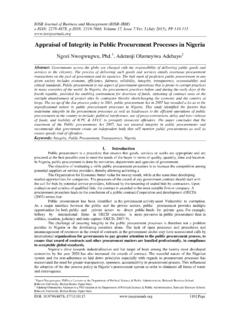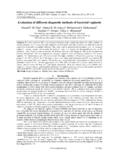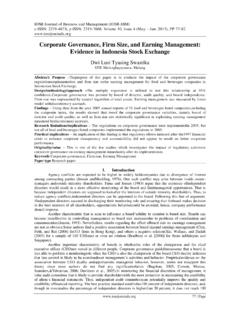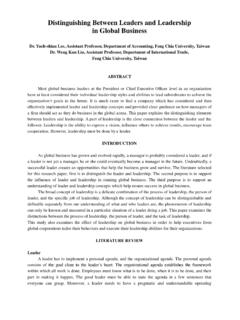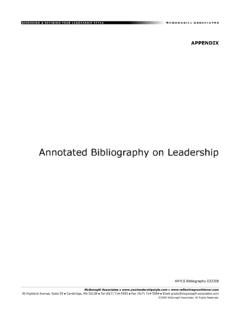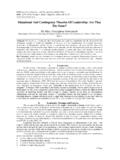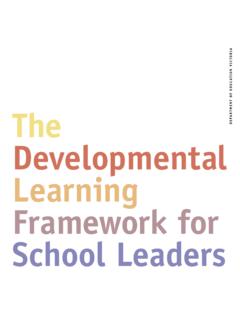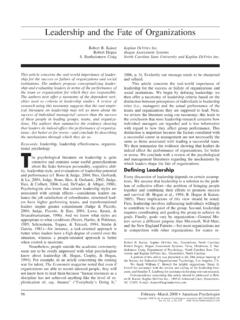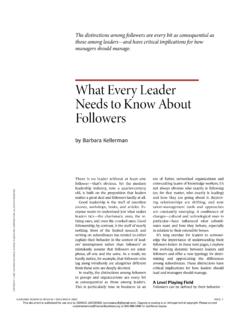Transcription of Effective Leadership-Employee Retention-Work Life Balance ...
1 IOSR Journal of Business and Management (IOSR-JBM) e-ISSN: 2278-487X, p-ISSN: 2319-7668. Volume 10, Issue 3 (May. - Jun. 2013), PP 80-86 80 | Page Effective Leadership-Employee Retention-Work Life Balance : A Cyclical Continuum * Nair , Dr. (Mrs.) Sonali Malewar Management Dept., MATS University, India Management Dept., MATS University, India Abstract: It is an interactive paper which has been made to explain the association between leadership and its impact on employee s work -life and employee retention .
2 Both the expressions have gained a lot of magnitude in these day s Organizations. leadership has been taken up as a foundation in the study as it builds up the essence of our Organizations; work -life Balance has also been addressed as a basic issue for the employees as well the employers. The study undertaken tries to explain in a theoretical and a very interactive way how Effective leadership can help balancing the work -life of employees and consecutively leads to help the Organization identify its quality employees and tap their efficiencies for a long-term through employee retention .
3 Keywords: leadership , leadership Focus, work -life Balance , employee retention , leadership Continuum. ROAD-MAP FOR THE DISCUSSION: I. Introduction: Bringing it all together: leadership is a continuous process of influencing people s behavior. A Leader breathes life into the group and motivates it towards goals. The lukewarm desires for the achievement are transformed into a burring Poisson for accomplishment. -Terry Rationale behind the Study: Human in nature have various psychological aspects in his work -life. No two human beings can be similar when they enact as boss in any Organization.
4 Every individual forms his own carcass of business strategy to work on. But do this dynamism in leading styles have a very positive impact on employees who are vital resources of any Organizations? The Mercer s 2012 Attraction and retention Survey states that more than 40% Organizations are expanding their overall workforce in 2012, compared to just 27% in 2010. Theoretical Framework: leadership is the process of influencing and supporting others to work enthusiastically towards achieving the objectives Barnard Keys and Thomas Case.
5 leadership styles are the patterns of behavior which a leader adopts in influencing the behavior of his followers. The styles are either based on behavioral approach or situational approach of leadership . Based on the Behavioral Approach: 1. Power Orientation Effective Leadership-Employee Retention-Work Life Balance : A Cyclical Continuum 81 | Page 2. leadership as a continuum 3. employee -production Orientation. 4. Likert s Management System 5. Managerial Grid. 6. Tri-Dimensional Grid. Based on Situational Approach: 1.
6 Fiedler s Contingency Model 2. Hursey and Blankard s Situational Model. 3. Path-goal Theory. Based on the above mentioned approaches, the leaders follow these all styles of leadership Styles: leadership STYLES AND THE leadership FOCUS: TRAITS THAT IDENTIFY leadership FOCUS: Trait: A characteristic feature or a quality distinguishing a particular person or thing . Effective Leadership-Employee Retention-Work Life Balance : A Cyclical Continuum 82 | Page leadership Focus Major Traits MANAGING THE SEA-SAW AT EQUIVALENCE: work -life Balance , in its broadest sense, is defines as a satisfactory level of involvement or fit between the multiple roles in a person s life.
7 -Hudson, 2005. Effective Leadership-Employee Retention-Work Life Balance : A Cyclical Continuum 83 | Page In totality, there are six elements of work -life Balance : Technology Management can be said as Using the technology for human advancements . An approach for transitioning oneself or your team is called as Change Management. Directing oneself towards achievement of the desired objectives is known as Self Management whereas improving the productivity is called as Time Management.
8 Stress Management is maintaining the Balance between the work -life Balance , fighting the work and issues of personal life. When we work , we tent to see relaxation as an equally important issue therefore; Leisure Management can be understood as realizing the importance of rest and relaxation in one s life. employee retention : The employees work in a place where they work in unison to achieve a common goal and it is strongly felt the need to retain the good employees. It is also said that the Organizations where the employees are not serious about their work and where their interests are taken over the interest of their organizations, such corporations are bound to sink.
9 employee retention is important because hiring is not an easy process; a lot of time is spent on hiring the candidates and to get them ready to face the challenging tasks and also to get them adjusted in the corporate culture. When the employees leave the Organizations, they are most likely to join the competitors; the more an employee works in the organization, more readily he will accommodate in the Organizational Culture. Lucrative salary, comfortable timings, growth prospects are some of the factors which prompt an employee to lookup for a change.
10 The main purpose of retention is to prevent the loss of competent employees for the long term (Chaminade, 2007). It is considered to be a voluntary move by an Organization to create an environment which engages an employee for a long term. Turnover is not only destructive to an Organization, it is rather costly affair. Michel (2008), argued that shortage of skilled manpower, economic growth and employee turnover makes employee retention more critical activity for the Organizational managers.
